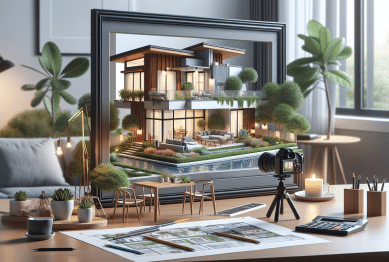Unlock the secrets behind increasing property worth with manageable upgrades and strategic planning. This guide explores practical tips for homeowners seeking to enhance home value without overwhelming renovation projects, all while weaving in important real estate trends and buyer preferences.
Understanding the Value Drivers in Residential Real Estate
Many homeowners often wonder what actually makes a property more desirable to buyers, or how some houses fetch higher offers than comparable homes nearby. It all comes down to identifying and leveraging key value drivers—those features and improvements that consistently increase home value in residential real estate. Location, size, condition, and layout remain fundamental. However, recent shifts show that buyers also care about energy efficiency, flexible living space, and modernized curb appeal. Real estate professionals emphasize that small but specific enhancements often create outsized impacts on perceived and appraised worth.
Understanding local market dynamics is crucial. For example, adding an extra bedroom or updated kitchen may mean more value in some areas, while others place premium on outdoor living space or smart home upgrades. Gathering insights from recent home sales in your neighborhood and studying buyer demand ensures your efforts are strategically focused. Making data-driven decisions—such as reviewing real estate agency reports and municipal assessments—can give your renovation investments a clear direction. Savvy homeowners also take note of shifting demographics, recognizing that families, remote workers, and downsizers each look for unique attributes in a residence.
Beyond bricks and mortar, emotional resonance plays a surprising role in property markets. Homes that feel inviting, flexible, and move-in ready often secure higher offers, even if their square footage is modest. Highlighting features like ample natural light, fresh paint, and low-maintenance landscaping can command attention. Maximizing your home’s potential, even through minor updates, sets it apart from neighboring options. Knowing the core value drivers means you can make choices that truly elevate your property’s status—without overspending or resorting to disruptive construction projects.
Modern Upgrades That Instantly Attract Buyers
Today’s buyers are savvy and trend-aware. Many prioritize modern upgrades that foster both comfort and long-term savings, such as energy-efficient windows, LED lighting, and smart thermostats. Integrating these high-performance features not only accommodates ecological trends but also appeals to prospective buyers seeking reduced utility costs. Real estate analysts note a steady increase in appraisal value when homes include sustainability upgrades, often yielding robust returns compared to traditional improvements.
Kitchens and bathrooms are often referred to as the heart of the home. Minor renovations—such as updating fixtures, resurfacing cabinets, or installing new countertops—can yield significant dividends without hefty costs. Fresh backsplashes, modern sinks, and stylish hardware provide instant visual appeal that influences buyer sentiment. Many people find that even replacing old appliances with energy-efficient models creates a ‘wow’ factor that stands out in property listings and in-person viewings alike.
Beyond interiors, attention to curb appeal goes a long way. Well-maintained lawns, attractive front doors, and modernized house numbers collectively boost perceived home value. Painting the façade or installing outdoor lighting may seem simple, yet these upgrades signal a well-cared-for property and set the tone for an inviting experience. According to real estate surveys, homes that make a positive first impression are not only quicker to sell but often see multiple competitive offers—demonstrating how smart updates can powerfully impact final sale prices.
Smart Home Technology and Its Role in Property Worth
As lifestyles evolve, so do buyer expectations. Smart home technology has moved from novelty to mainstream in property markets, with features such as security cameras, smart locks, and automated climate control now standard requests. Homes equipped with Wi-Fi-enabled devices attract interest from tech-savvy buyers and foster a sense of modern living, even in older structures. Surveys suggest that smart home tech typically leads to quicker sales and higher appraisals, especially in urban markets.
Incorporating smart features is surprisingly accessible. Wireless thermostats, programmable lighting, and voice-activated assistants can often be installed without structural changes. This approach demonstrates adaptability and future-readiness without the need for expensive rewiring or major modifications. Buyers recognize time-saving and security benefits provided by these devices, often equating technological enhancement with higher home value. Homeowners who embrace smart tech position their listings at the forefront of market trends.
Of equal importance is the ability to showcase smart tech to buyers during viewings. Demonstrating how a thermostat adjusts remotely or security cameras provide real-time updates creates an interactive, memorable impression. Real estate experts highlight that even modest investments in technology can influence purchase decisions, especially among millennial and Gen Z buyers. In turn, these upgrades may also improve energy efficiency ratings—further boosting the property’s appeal in eco-conscious segments of the market.
Curb Appeal and Outdoor Spaces as Investment Magnets
Curb appeal shapes first impressions that influence both buyer psychology and valuation. Attractive exteriors, manicured landscaping, and clear entryways can transform an ordinary property into a standout. Homeowners with limited budgets may focus on simple, high-impact projects like fresh mulch, seasonal flowers, and pressure-washing driveways. Such efforts create a welcoming appearance and signal care that echoes throughout the house tour.
Outdoor living space holds substantial sway in current markets. Decks, patios, and even modest seating areas expand usable square footage without new construction. These additions enhance lifestyle flexibility and align with the growing demand for at-home relaxation or entertaining. Upgraded fencing, solar lighting, and garden beds further distinguish homes—often commanding a premium from buyers seeking both function and aesthetics.
For many, the pathway to higher home value lies not in massive projects but in routine attention. Maintaining gutters, tidying up vegetation, and ensuring clear paths signal maintenance, which can reduce concerns over unanticipated expenses. Real estate research links strong curb appeal with faster sale times and higher closing offers, confirming that investment in outward appearance is as practical as it is eye-catching.
Low-Cost Improvements with Powerful Returns
Maximizing home value does not always require deep pockets. Simple projects—fresh paint, updated light fixtures, or new cabinet pulls—deliver immediate impact at a modest cost. Focusing on neutral colors and timeless assets makes it easier for buyers to envision themselves in the space, which accelerates interest and shortens sales cycles. Professional cleaning and minor repairs similarly elevate a home’s perceived care and readiness.
Optimizing floor plans through creative staging is another effective tactic. By rearranging furniture, removing clutter, and opening up sightlines, spaces feel larger and more functional. Adding mirrors or accent lighting further increases the sense of openness, making smaller homes more competitive with their larger counterparts. Experienced agents often stress that well-staged properties regularly outperform unprepared listings—sometimes securing offers above the listing price.
Finally, investing in healthy indoor air—such as changing HVAC filters, adding greenery, or reducing allergens—can be both affordable and impactful. Buyers increasingly ask about environmental quality, seeking assurances that a home is safe and comfortable. Fulfilling those needs, even through small investments, demonstrates attention to detail and can set a property apart when buyers face multiple choices in a competitive market.
Navigating Permits, Codes, and Professional Guidance
Before embarking on major updates, it’s essential to understand local building requirements and obtain permits for structural, electrical, or plumbing work. Many homeowners are surprised to learn that even minor changes can require approval from municipal authorities. Failing to secure necessary documentation sometimes results in costly delays or penalties during the selling process. Knowledge of local codes and standards not only avoids legal pitfalls but also builds buyer confidence in the quality of improvements.
Consulting with real estate professionals or contractors early in a project ensures efficient, compliant upgrades. Agents offer perspective on which improvements yield the highest returns for specific areas, while licensed contractors ensure code compliance and safety. Town planning departments may provide workshops or checklists, helping homeowners navigate application procedures and necessary inspections. Established research shows that properties with documented renovations often command higher prices and smoother transactions.
Finally, working with skilled specialists safeguards investments and simplifies disclosures during the selling process. Appraisers and inspectors welcome accurate information on permitted work, which can help justify higher listing prices. Understanding the paper trail of improvements reassures buyers and smooths closing negotiations, while also protecting against post-sale liability. For complex or high-value upgrades, the assurance of professional oversight is a practical step toward maximizing long-term property value.
References
1. National Association of Realtors. (n.d.). 2022 Remodeling Impact Report. Retrieved from https://www.nar.realtor/reports/remodeling-impact-report
2. U.S. Department of Housing and Urban Development. (n.d.). Making Homes Energy Efficient. Retrieved from https://www.hud.gov/program_offices/healthy_homes/energyefficienthomes
3. National Association of Home Builders. (n.d.). Cost vs. Value: Home Improvement Projects with High ROI. Retrieved from https://www.nahb.org/other/consumer-resources/why-buy-new/roi-home-improvements
4. Federal Trade Commission. (n.d.). Hiring a Contractor. Retrieved from https://consumer.ftc.gov/articles/hiring-contractor
5. Energy Star. (n.d.). Save Energy at Home. Retrieved from https://www.energystar.gov/saveathome
6. American Planning Association. (n.d.). Home Improvements and Property Value. Retrieved from https://planning.org/pas/reports/report320.htm









